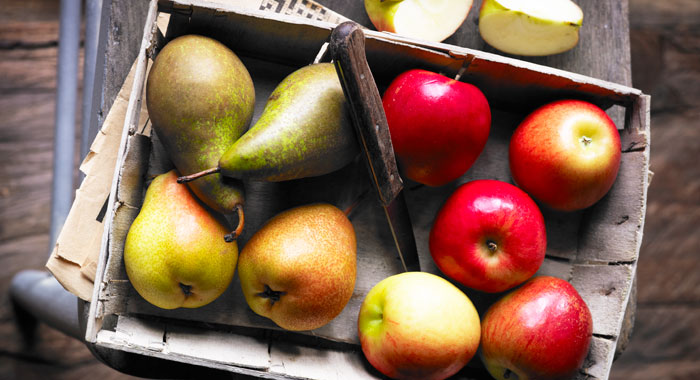
Pronounce it: pair
Like apples, to which they are related, pears come in thousands of varieties, of which only a small fraction are sold in the UK. Their fine, slightly granular flesh is much more fragile than apples and, unlike most fruit, they improve in flavour and texture after they’re picked.
Most pears are wider at the bottom than they are at the top, though a few varieties are more spherical in shape. They’re not as brightly coloured as apples, most having skins that range from dull bronze through to soft green, though you can also find red varieties such as Red William.
Availability
In season from September through to January.
Choose the best
Pears are very delicate and bruise easily when ripe, so always buy slightly underripe (they should be firm but not hard), then ripen at home. They ripen from the inside out – when they’re ready they should give a little at the base. Avoid any pears that are mushy or bruised.
Choose your pear according to your taste – here’s a rundown of some of the main varieties available in the UK.
Conference has a long, conical shape, with a yellow skin with russet markings. Its flesh is grainy, sweet and juicy and it cooks and eats well.
Comice is more bulbous in shape, and has juicy, meltingly tender flesh; it’s good for cooking and eating, particularly with cheese.
Concorde is a cross between Comice and Conference.
Packham’s is native to Australia, has a wide-bottomed shape and a smooth green skin that ripens to yellow. It’s succulent and is great to eat raw.
The green-skinned Anjou is large, sweet and good for cooking and eating.
Red William has a speckled, bright red skin, and buttery, sweet flesh.
Rocha, from Portugal, has firmer flesh and is juicy and sweet.
Williams Bon Chrétien is tender and juicy, and good for cooking and eating.
You can also find Asian (or Nashi) pears – they have the shape and crisp texture of an apple and their sweet flesh is best eaten raw.
Prepare it
Wash. Their skin is edible, but they can be peeled a number of ways. If you want to keep them whole, leave the stem on, then use a vegetable peeler to peel down along their length.
If you want to cut into chunks, slice into quarters, cut out the core, then peel with a sharp knife.
To stuff a pear before cooking it, you should leave the skin on; just cut in half lengthways, then scoop out the core with a teaspoon.
Finally, if you’re not going to eat cut pears straight away, brush the cut sides with lemon juice or acidulated water to prevent them going brown.
Store it
If you buy underripe pears, keep them in a fairly cool place until they are ready to eat. They can then be stored in the fridge, but should be eaten as soon as possible.
Cook it
When cooking with pears, choose slightly underripe ones, as they’ll keep their shape better.
Poach whole (15-25 minutes); quarter and roast (20-25 minutes); cut into wedges and grill or pan fry (4-5 minutes). Serve with a cheese board; add to blue cheese salads; use in baking; make into chutney.
Alternatives
Try apple.
Be the first to comment on "Pear"